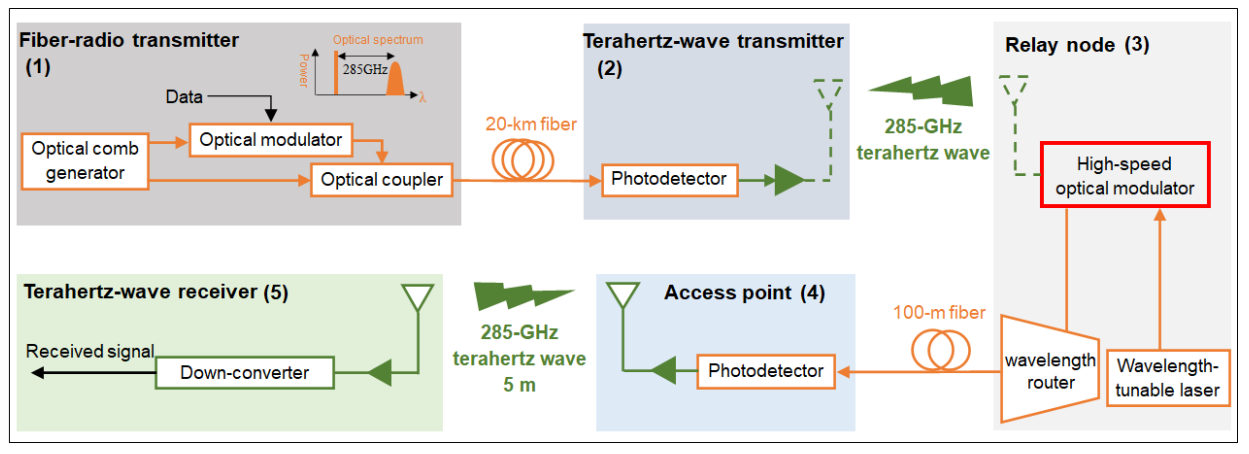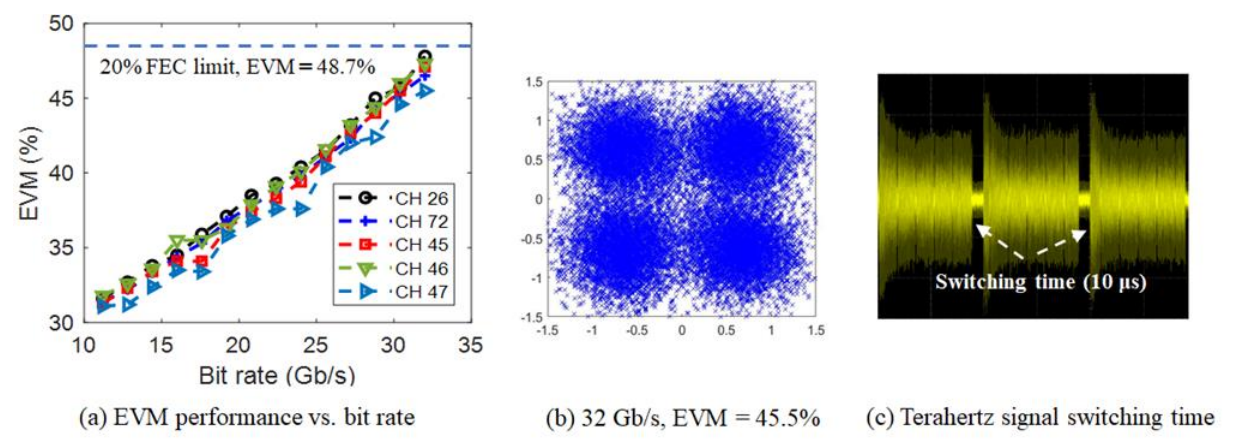World’s First Demonstration of Terahertz Signal Transparent Relay and Switching
Tue, Jun 6, 2023-
Tags
World’s First Demonstration of Terahertz Signal Transparent Relay and Switching
【Highlights】
World’s first system for the transparent relay, routing, and switching of high-capacity terahertz-wave signals to different locations.
The transparent relay and switching of terahertz-wave signals in the 285-GHz band using direct terahertz–optical conversion and fiber–wireless technology was demonstrated, achieving a capacity of 32 Gb/s.
The system paves the way for the deployment of terahertz communication in beyond 5G networks.
【Abstract】
The National Institute of Information and Communications Technology (NICT, President: TOKUDA Hideyuki, Ph.D.), Sumitomo Osaka Cement Co., Ltd. (President: MOROHASHI Hirotsune), Nagoya Institute of Technology (President: Dr. KINOSHITA Takatoshi), and Waseda University (President: TANAKA Aiji, Ph.D.) jointly developed the world’s first system for the transparent relay, routing, and switching of high-speed terahertz-wave signals to different locations. Direct conversion of a 32-Gb/s terahertz-wave signal in the 285-GHz band to an optical fiber and its transparent relay and switching to different access points in ultrashort time periods were successfully demonstrated.
The key technologies include a newly developed low-loss optical modulator*1 for the direct conversion of terahertz-wave signals to optical signals*2 and an adaptive fiber–wireless technology for the ultrafast switching of terahertz signals*3. The developed system overcomes the disadvantages of radio communications in the terahertz band, such as high free-space loss, weak penetration, and limited communication coverage, paving the way for the deployment of terahertz communications in beyond 5G and 6G networks.
The results of this demonstration were published as a postdeadline paper at the 2023 International Conference on Optical Fiber Communications (OFC 2023) and were presented on Thursday, March 9, 2023 (local time).
【Background】
Radio frequencies in the terahertz band are promising candidates for ultrahigh-data-rate communications in beyond 5G and 6G networks. A 160-GHz slot in the 275–450 GHz band was recently opened for mobile and fixed services. However, high free-space loss and weak penetration remain as bottlenecks, making it difficult to transmit signals over long distances, such as from outdoors to indoors or in environments with obstacles. Transparent relay and routing of terahertz signals between different locations are crucial to overcome these disadvantages and expand communication coverage. However, these functions cannot be realized using current electronic technologies. In addition, the narrow beamwidth of terahertz signals makes it difficult to achieve uninterrupted communication when users are moving. Terahertz-signal switching between different directions and locations is crucial for maintaining communication with end users. However, this critical issue has not yet been addressed using electronic or photonic technologies. It is also important to turn on and off the emission of terahertz signals at appropriate intervals to save energy and reduce interference.

Figure 1 Concept of transparent relay and switching of terahertz-wave signals using direct terahertz–optical conversion and optical wavelength control.
【Achievements】
In this study, we demonstrated the first system for the transparent relay, routing, and switching of terahertz signals in the 285-GHz band (see Figure 1) utilizing two key technologies: (i) a newly developed low-loss optical modulator and (ii) an adaptive fiber–wireless technology using an ultrafast wavelength-tunable laser. In the system, terahertz signals are received and directly converted into optical signals using terahertz–optical conversion devices with low-loss optical modulators. Lightwave signals from tunable lasers are input to the modulators, and wavelength routers are used to route the signals to different access points where specific wavelengths are assigned. At the access points, the modulated optical signals are converted back into terahertz signals using optical–terahertz converters. Terahertz signals can be switched to different access points by switching the wavelengths of the tunable lasers. The tunable lasers can be independently controlled, and the number of access points that can simultaneously generate terahertz signals equals the number of active tunable lasers. Using the technologies developed in this study, we successfully demonstrated the transparent relay and switching of terahertz signals in the 285-GHz band for the first time and achieved a transmission capacity of 32 Gb/s using a 4-quadrature amplitude modulation (QAM) orthogonal frequency division multiplexing (OFDM) signal*4. The possibility of switching the terahertz-wave signals in less than 10 μs was evaluated, confirming that uninterrupted communication can be attained in the terahertz band.

Figure 2 Image of direct terahertz–optical conversion.
The system consists of the following key element technologies:
- Direct conversion of terahertz signals to optical signals using a newly developed low-loss optical modulator (see Figure 2): This was achieved by performing Ti diffusion on the x-cut lithium niobate (LiNbO3 thickness: ≤ 100 µm) in the low dielectric constant layer for operation up to 330 GHz.
- Ultrafast terahertz-signal switching by controlling the wavelengths of tunable lasers to route and distribute terahertz signals to different locations
- 4-QAM OFDM signal transmission
By transparently relaying and distributing terahertz signals to different locations, high free-space and penetration losses of radio signals in the terahertz band can be overcome, and communication coverage can be significantly extended. In addition, by promptly routing and switching the signals to different directions/locations, communication can be maintained even when obstacles occur and/or users are moving. Furthermore, by turning on and off the emission of terahertz-wave signals from access points at appropriate intervals, energy savings and interference reduction can be achieved. These features render the proposed system a promising solution for overcoming the bottlenecks of terahertz-wave communications and paving the way for its deployment in beyond 5G and 6G networks.
【Future Prospects】
In the future, we will study the terahertz–optical conversion device and fiber–wireless technology developed in this study to further increase the radio frequency and transmission capacity. In addition, we will promote international standardization and social implementation activities related to fiber–wireless and terahertz-wave communication systems.
The results of this demonstration were published at the 2023 International Conference on Optical Fiber Communication (OFC 2023, March 5 (Sunday) to March 9 (Thursday)), one of the largest international conferences in the field of optical fiber communication. It was highly evaluated and presented on Thursday, March 9, 2023 (local time) at the postdeadline session, which is known to release the latest important research achievements.
【References】
International Conference: 2023 Optical Fiber Communications (OFC 2023), March 2023, paper Th4A.6 (PostDeadline Paper)
Title: Transparent Relay and Switching of THz-wave Signals in 285-GHz Band Using Photonic Technology
Authors: Pham Tien Dat, Yuya Yamaguchi, Keizo Inagaki, Shingo Takano, Shotaro Hirata, Junichiro Ichikawa, Ryo Shimizu, Isao Morohashi, Yuki Yoshida, Atsushi Kanno, Naokatsu Yamamoto, Tetsuya Kawanishi, Kouichi Akahane
【Previous NICT Press Releases】
“Towards Uninterrupted Communication for Users Moving at 500 km Per Hour”
https://www.nict.go.jp/en/press/2018/05/08-1.html
“World’s First Transparent Fiber-Millimeter-wave-Fiber System in 100-GHz Band Using Low-Loss Optical Modulator and Direct Photonic Down-Conversion”
https://www.nict.go.jp/en/press/2021/08/06-1.html
【Glossary】
*1 Low-loss optical modulator
A broadband Mach–Zehnder modulator (MZM) can be fabricated using a thin substrate. To create the broadband MZM in this study, Mach–Zehnder interferometer waveguides were fabricated by Ti diffusion on the x-cut lithium niobate (LiNbO3 thickness: ≤ 100µm) in the low dielectric constant layer. This was performed to achieve a ripple-free operation and maximize the electro-optic responsivity up to 330 GHz. By thinning the substrate, as shown in Figures 3(a) and (b), the frequency ripple due to mode coupling between the coplanar guided mode and the substrate mode can be suppressed. The electrodes were also optimized to reduce electrical propagation loss and attain high sensitivity. The optical insertion loss, including fiber pigtails, was approximately 4.3 dB at 1,550 nm.

Figure 3 Cross-sectional structure of optical modulator: (a) conventional structure, (b) thin substrate.
*2 Direct conversion of terahertz-wave signals to optical signals
It is a technology that converts a wireless signal in the terahertz band to an optical signal without frequency down-conversion. In contrast, in the electronics-based conversion method, the terahertz-wave signal must be down-converted to a lower frequency signal in the microwave band before its conversion into an optical signal. The direct conversion of a terahertz-wave signal into an optical signal can be realized using a broadband optical or plasmonic modulator, which significantly simplifies the antenna site.
*3 Adaptive fiber–wireless technology for ultrafast switching of terahertz signals
It is a technology for routing and switching terahertz-wave signals by controlling the wavelengths of optical carrier signals. In this technology, light wave signals from wavelength-tunable lasers are input into terahertz–optical converters to implement terahertz-wave signal modulation. Modulated optical signals at different wavelengths can be generated by changing the wavelengths of the tunable lasers and can be routed and distributed to different access points using wavelength routers. At the access points, the modulated optical signals are converted back to terahertz-wave signals using optical–terahertz converters. The switching time of the terahertz signal equals the time for switching the wavelengths of the tunable lasers plus the delays on the transmission paths. A total switching time of less than 10 μs was confirmed in the demonstration.
*4 4-QAM OFDM signal
OFDM is a digital multicarrier modulation scheme that uses multiple subcarriers within the same single channel. Instead of transmitting a high-rate data stream using a single subcarrier, OFDM uses numerous closely spaced orthogonal subcarriers that are transmitted in parallel. In this study, the subcarriers were modulated with four QAM symbols, each consisting of two input data bits.
Appendix
1. Configuration of the proposed system

Figure 4 Schematic diagram for transparent terahertz-wave signal relay and switching.
Figure 4 shows a schematic of the proposed system, which includes five main parts: a fiber–radio transmitter, a terahertz-wave radio transmitter, a relay node, an access point, and a terahertz-wave receiver.
(1) Fiber–radio transmitter
This block generates and modulates signals. An optical frequency comb signal was generated using a single dual-drive optical modulator. Two comb lines with a frequency difference of 275.2 GHz were selected, one of which was modulated using an OFDM signal at 9.8 GHz. The bias voltage applied to the modulator was controlled to generate only the upper modulation sideband. The modulated and unmodulated signals were combined to form a 285-GHz radio-over-fiber (RoF) signal.
(2) Terahertz-wave radio transmitter
After transmission over a 20-km single-mode fiber, the RoF signal was up-converted to a 285-GHz terahertz-wave signal using a high-speed photodetector. The generated radio signal was amplified and could be emitted into free space using a terahertz-wave antenna. For simplicity, the terahertz-wave signal was connected directly to the terahertz–optical converter at the relay node.
(3) Relay node
The terahertz-wave signal could be received using a terahertz-wave antenna. In the demonstration, the signal was received using a waveguide and connected to the developed optical modulator using an RF probe for conversion into an optical signal. Optical carrier signals from a wavelength-tunable laser were connected to the optical modulator for signal modulation. The modulated optical signals were connected to a wavelength router for transport to different access points, where specific wavelengths are assigned.
(4) Access point
The signal was input to another high-speed photodetector to convert it back to a terahertz-wave signal in the 285-GHz band. The signal was amplified and transmitted into free space using a 48-dBi lens antenna.
(5) Terahertz-wave receiver
The terahertz-wave signal was received using another lens antenna, amplified, and downconverted to 10.2 GHz using a subharmonic mixer. Finally, the signal was amplified, sent to a real-time oscilloscope, and demodulated.
2. Experimental results

Figure 5 Transmission performances:
(a) OFDM signal performance vs. data rate;
(b) Constellation of 32-Gb/s 4-QAM OFDM signal;
(c) Switching time of terahertz-wave signal of less than 10 μs.
In the demonstration, an OFDM signal was generated and transmitted over the system. The performances in terms of error vector magnitude (EVM) for different data rates after transmission over the system using optical carrier signals at different wavelengths are plotted in Figure 5(a). A signal with a line rate of 32 Gb/s was successfully transmitted over all channels, with EVM values below the 20% forward error correction overhead limit of 48.7%. The constellation of the received 32-Gb/s signal with an EVM value of 45.5% is shown in Figure 5(b). Switching of terahertz signals between access points is important for maintaining connectivity and communication. The switching of the terahertz-wave signal was evaluated by varying the wavelengths of the tunable laser. To simplify the measurement, one output of the wavelength router was expanded to pass through all the modulated signals when the wavelengths of the optical carrier signals were set at channels 45, 46, and 47. The tunable laser was set to auto-switching mode between channels 45, 46, and 47, and the signals received in the time domain were recorded. Figure 5(c) shows the time period during the signal switching, in which a fast signal switching time of less than 10 μs was observed. A sudden increase in the received signal after the signal switching was caused by the optical surge of the optical amplifier and could be suppressed using a burst-mode amplifier.













